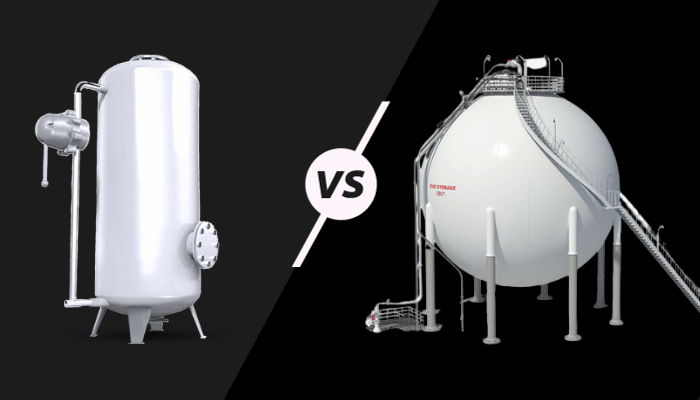Spherical or cylindrical tank? This is a question that may concern the minds of many people
Pressure vessels are one of the vital components in various industries, especially in the oil, gas and petrochemical industry. Choosing the right type of pressure tank for a project is very important and depends on various conditions such as required volume, pressure and temperature, industrial standards and regulations, liquid or gas characteristics, and economic factors. In this article, we examine and compare different types of spherical and cylindrical pressure vessels.
Spherical pressure vessels
Spherical pressure vessel is a type of tank that has a spherical or as if (three-dimensional) shape. These types of tanks are mainly used to store liquids and gases under pressure in different scales. The spherical shape of the tank has several advantages due to the uniform distribution of pressure in all its points.
The advantages of the spherical pressure tank include:
Uniform distribution of pressure: The spherical shape of the tank causes the internal pressure to be evenly distributed to all points of the tank and prevents the tendency to crack or break due to weak points.
Specific Volume for Liquids: Spherical tank is known as a specific volume tank and due to its circular volume, it can store more volume of liquids compared to tanks with different shapes.
High resistance power: the spherical shape increases resistance to pressure, and spherical tanks have the ability to withstand high pressures.
Less space required: compared to cylindrical tanks of the same volume, spherical tanks require less space.
For example, spherical tanks are commonly used in the petrochemical, oil and gas industries, and other industries that require compressed gas storage. Choosing the right type of tank for each application depends on the type of liquid or gas, the pressure required, and the environmental conditions.
Cylindrical pressure vessels
Cylindrical pressure vessel is a type of pressure vessel that has a cylindrical shape. These tanks are mainly made of metal materials such as steel and are used in many industries to store different pressures of liquids or gases. Their cylindrical shape causes uniform pressure distribution inside the tank.
Cylindrical pressure vessels have two heads (serfs), which are mostly circular in shape. One head is known as the upper head (Head) and the other as the lower head (Bottom). Usually, there are connections at the upper end of the tank for the entry and exit of liquids or gases.
Advantages and disadvantages of cylindrical pressure tank:
Advantages:
Ability to store high pressure: Cylindrical pressure vessels are able to maintain and store high pressures for different liquids or gases.
Resistant structure: The cylindrical structure of these tanks provides them with great resistance to pressure.
Ease of maintenance: Usually, maintenance and repair of cylindrical tanks is done easily.
Disadvantages:
More space: Cylindrical tanks need more space due to their shape and dimensions.
High weight: due to the use of heavy materials, the weight of cylindrical tanks is usually relatively high.
Cylindrical pressure tanks are used in various industries such as oil and gas, petrochemical, chemical, and construction industries for storing and distributing liquids and gases with a certain pressure. Choosing the right type of pressure tank for each project depends on the specific needs and conditions of that project.
Compare and choose the best type of tank
The choice between a spherical tank and a cylindrical tank depends on various things, and the specifications and specific needs of each application and industry should be taken into account. Below we have reviewed a number of factors that may influence the decision on the right type of pressure vessel:
Pressure rating: If you need to store liquids or gases under high pressure, spherical tanks have an advantage due to their greater strength against pressure.
Volume and space: Spherical tanks are known as tanks with a specific volume and are placed in a limited space. If you have limited space, a spherical tank may be more suitable. Otherwise, the cylindrical tank usually has a larger volume.
Cost: Spherical tanks usually have higher construction and installation costs. Cylindrical tanks are typically more cost-effective.
Transportation requirements: Spherical tanks may be more difficult to transport and install tenders due to their circular shape.
Installation position: The installation position of the tank is also influential. In some cases, it may be more appropriate to install a spherical tank due to the limited space available.
Appearance and capacity: Spherical tanks usually have a more attractive appearance and can be considered as decorative elements. They may also be used as a larger storage option in a few cases due to their higher storage capacity.
Liquid material: The type of liquid or gas that must be stored in the tank also plays an important role in choosing the type of tank. Some materials are more suitable in spherical tanks due to certain characteristics such as density and viscosity.
Variety of products: In some industries and applications, the variety of tank products (such as flat tanks, Argentina, etc.) may be an advantage and depends on various factors.
Therefore, the decision between a spherical tank and a cylindrical tank should be made according to specific application needs and environmental conditions. Most engineers and industrial experts can determine the best option according to the specific characteristics of the project.
Conclusion
In this article, all types of spherical and cylindrical pressure vessels in fixed equipment were investigated and compared. Each of these types of tanks has its advantages and disadvantages, and choosing the best type depends on the specific needs of each project. This choice should be made according to factors such as required volume, pressure and temperature, industrial standards and regulations, characteristics of liquid or gas, need for insulation and safety, and economic factors. In this way, the best pressure vessel can be determined for each project.


